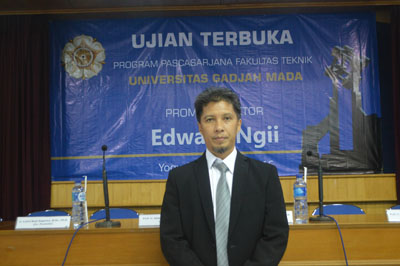
Pavement rehabilitation is one way to improve capacity of road pavement structure due to increased vehicle loads or massive pavement damage. It is also used to rehabilitate airport areas.
Engineering lecturer from Halu Oleo University, Edward Ngii, said overlay method was the most popular one compared to the re-designing. In Indonesia, concrete overlay method is used to spread out directly concrete mix over existing rigid pavement known as bonded overlay, however, this method is vulnerable to reflection cracks.
“The impact of reflection crack can cause improved pavement strength decreasing, hence shorter service period,” he said on Thursday (21/7) during his doctoral promotion at Environment and Civil Engineering Department at UGM.
With his dissertaton titled Mechanical Characteristics of Rubber Concrete as Stress Absorbing Membrane Interlayer (SAMI) in Overlay Over Airport Rigid Pavement, Edward said Stress Absorbing Membrane Interlayer (SAMI) was an interlayer material good for asphalt overlay. Previous studies showed that SAMI-LDPE has eficiency to endure reflection crack of flexible pavement overlay up to 62 percent. But, the use of SAMI in concrete overlay has low performance in enduring reflection cracks. Other studies revealed that rubber concrete can be designed to have mechanical characteristics similar to that of SAMI.
Therefore, Edward researched and designed use of rubber concrete as interlayer in concrete overlay for airport pavement called as SAMI-Rubbercert. A function of SAMI in overlay system is to break the bond so the overlay and existing move independently. It also guarantees damage in existing layer to not reflect directly on the overlay.
His research showed that composition of rubber concrete mix that can be used as interlayer in overlay of rigid pavement for SAMI-RC60 is 60 % rubber and 40% sand. For SAMI-RC80 it is 80% rubber and 20% sand. Flexible behaviour of SAMI-RC80 causes the interlayer more enduring to the maximum load in overlay blocks that experience cracks.
Edward added between interlayer SAMI-RC60 and AMI-RC80 there has been no significant influence to slopes in the overlay. But the results showed flexible behaviour is close to the lab test results in dual wheel gear loads.
In his opinion, the use of interlayer would benefit users as it can be spread out directly on the old damaged concrete, thus saving costs and time. Rubber for akan interlay may use rubber from waste tyres so it also minimises environmental negative impacts.


